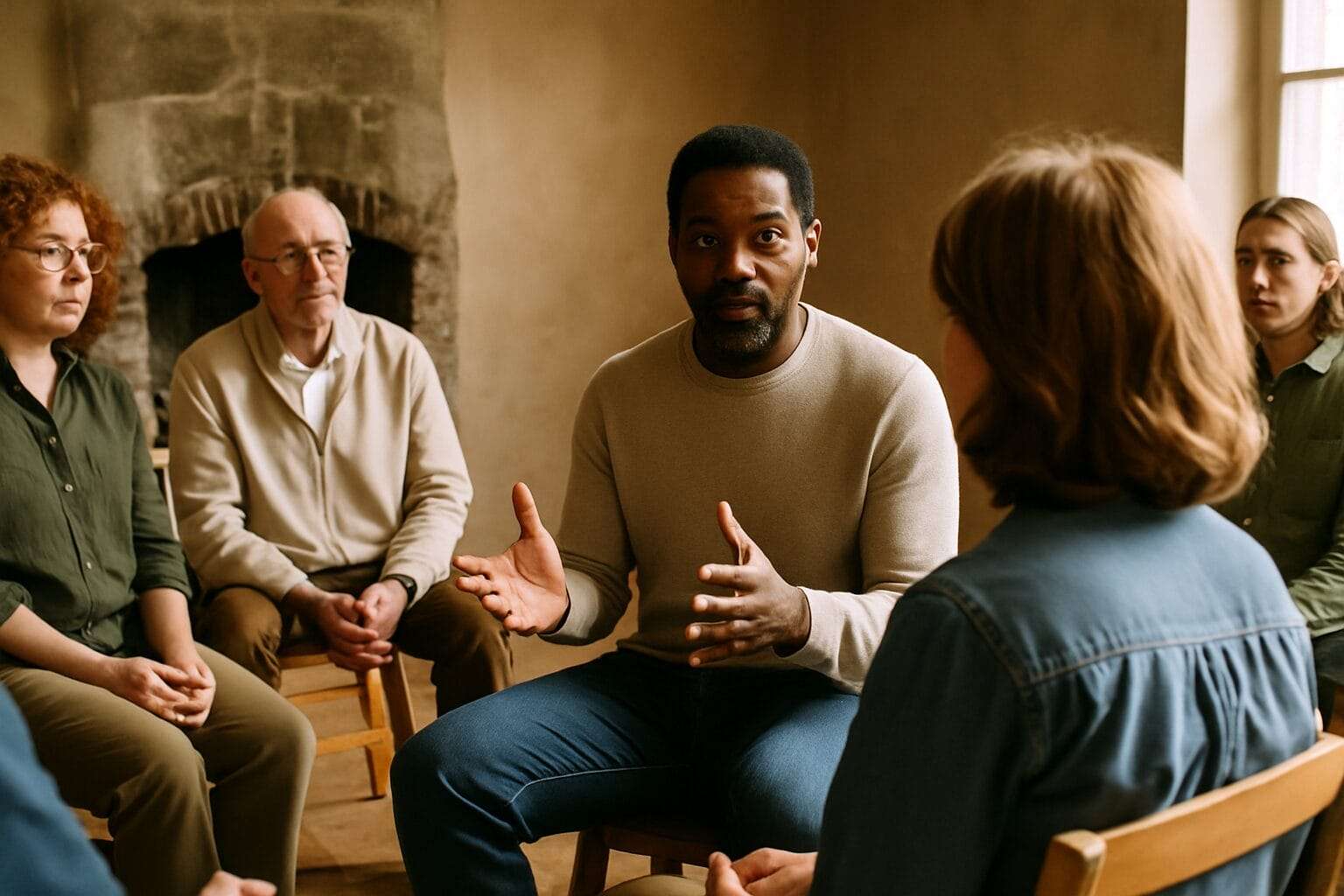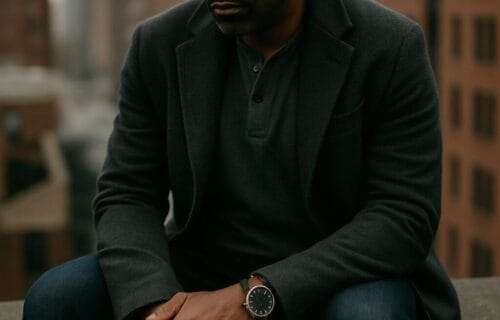
Why Healing in Community Isn’t Weakness—It’s How We Were Meant to Survive
You were never meant to go through this alone.
But somewhere along the line, we were told healing was a solo assignment. Like it was homework you did quietly, turned in at the end, and hoped you passed.
The shame? The secrecy? That didn’t come from your soul.
It came from a system that forgot what it means to be human.
And now here you are—leading a team, managing a company, holding up a family—trying to heal quietly while performing competently. You can’t spreadsheet your way out of soul wounds. But that’s what this culture taught you to try.
In this post, we’re unpacking the roots of that shame—so you can stop gaslighting yourself and start remembering how healing was always meant to happen: in relationship.
Why We Heal Alone—And Why We Don’t Have To
🧠 The Real Reason We Think We Have to Heal Alone
We hear a lot about self-healing these days—like it’s some noble badge of emotional fitness.
But where did we get the idea that asking for help was a character flaw?
The deeper truth?
Most of us were taught—explicitly or implicitly—that being seen in your struggle meant being disqualified.
Especially in high-pressure spaces like corporate leadership, ministry, or entrepreneurship, the message is clear:
Heal quietly.
Stay competent-looking.
Because if you do?
You might be seen as “one of the broken ones.”
And we all know what happens to those people.

👀 Let’s Get Honest:
🔎 Personal Prompt:
What 2–3 beliefs did you internalize that made you hide your pain or feel ashamed for needing help?
You don’t have to post it publicly.
But name it. Call it out.
That’s where the unshaming begins.
Here’s mine:
“Nobody trusts someone who’s a screwup.”
I’ll never forget working at a grocery store in college.
The new store manager? He was a former district manager—demoted after a failure that might have involved an office romance. Married man. Rumors everywhere.
Everyone whispered about him like he was radioactive. A fallen man. A warning.
Not a word about how hard it is to stay in an organization that demotes you.
Not a word about how to support someone through moral failure, leadership loss, or personal grief.
He was a “screwup.” End of story.
Internalizes Shame Lives Everywhere
And I learned quickly:
If you talk too much about your mistakes, they’ll label you a mistake.
Not someone to guide. Not someone to help.
Just a liability waiting for paperwork.
That message repeated everywhere—
In my family.
In college.
In internships.
In corporate.
Only the “talented ones” got attention and support.
Everyone else got gossip… or a performance improvement plan before the boot.
👉 That internalized shame doesn’t just live in your nervous system. It lives in your company culture.
And if you don’t name it, you’ll pass it on—even if you don’t mean to.
But here’s the truth:
You weren’t weak for needing help.
You were surrounded by people who had no idea how to offer it safely.
🎭 When Healing Became a Performance (and Why It Stuck)
It didn’t used to be like this.
There was a time when healing meant being surrounded—not branded.
Held in the midst of your unraveling.
Seen through—not seen past.
But then something shifted.
Healing became a product. A pitch. A professional development plan.
Now, you’re supposed to bounce back with a toolkit, a morning routine, and a perfectly worded “breakthrough” post by next quarter.
And if you’re still messy, still scared, still unraveling?
You’re just… not “ready.”
You’re “in resistance.”
You’re “lacking accountability.”
We turned recovery into a performance review.

💰 The Business of Brokenness
Let’s not pretend this is just personal.
The wellness, therapy, and coaching industries—yes, even the ones that mean well—are now worth over $4 trillion globally.
Healing has been professionalized, branded, and sold back to us… in 12-week programs, AI-generated affirmations, and viral vulnerability.
Meanwhile:
Fewer than 25% of U.S. adults with mental health conditions get adequate support.
Suicide rates are climbing among high-functioning professionals.
Leaders in burnout cycles are still being told to “take a day off and practice gratitude.”
We aren’t solving the crisis.
We’re packaging the pain.
😔 Why We Don’t Tell the Truth (Until We Break)
For years, I didn’t tell the full truth either.
Not until I was surrounded by people who didn’t just manage me—they cared.
Real healing started when I joined a trauma recovery group.
Not a flashy mastermind. Not a performance-based leadership circle.
Just people sitting in a room, choosing honesty over optics.
People who weren’t there to network or posture.
They were there to heal. Together.
That was the first time I realized:
I didn’t need more strategies.
I needed witnessing.
I needed people invested in my wholeness—not just my maintenance or damage control.
“We optimize pain so we don’t have to feel it.
We monetize healing so we can avoid needing each other.
And we confuse ‘doing better’ with being okay.”
🤔Something to think about
What’s one way you’ve felt pressure to “perform” your healing?
Was it in your business? In a family role? In front of your team?
Write it down—and ask yourself: who taught me that healing had to look impressive?
🔇 The Quiet Shame Around Needing People
Most people don’t mean to shame others for needing help.
They just don’t have a healthy blueprint for what communal healing looks like.
So instead, they default to:
“Don’t trauma dump on people.”
“Boundaries, not burdens.”
“It’s not my job to fix you.”
And on the surface? Sure—those can be healthy sentiments.
But underneath?
They often mask a deeper cultural sickness: emotional avoidance disguised as personal responsibility.
We’re terrified of being “too much.”
And equally terrified of letting someone else be too much around us.
So we ghost.
We shrink.
We advise from a distance instead of sitting in the fire.
And then we call it empowerment.

👣 Where It Starts: The Personal Side of Collective Silence
For many years, I didn’t even think about talking openly about my pain.
In my family of origin, nobody talked about suffering unless it had a financial cost or a public consequence.
Mental illness? Never named.
Loneliness? Treated like laziness.
Exhaustion? Just poor time management.
The message wasn’t always cruel—but it was clear:
“As long as you’re not embarrassing anyone, keep it moving.”
So I did.
I learned to grieve silently.
To mask depression with overachievement.
To view asking for help as risking humiliation.
Communal healing wasn’t normalized—it was pathologized.
You were either “in control” or “one of those people.”

🧱 How “Boundaries” Replaced Belonging
Even in today’s healing spaces—coaching, therapy, faith communities—these subtle forms of shame creep in:
Group shares that subtly rank who’s “doing the work” better
Leaders who overuse “boundaries” to mask emotional inaccessibility
Peer groups that support “as long as you’re improving”
We end up recreating the same isolation in rooms meant for belonging.
And people leave thinking:
“I must be the only one not healing fast enough.”
Or worse:
“If I’m this messy, maybe I don’t belong in this group after all.”
I didn’t feel safe enough to tell the truth until I was surrounded by people who weren’t waiting for me to be impressive.
Just present.
Just willing.
Just real.
💥 Why Private Healing Fails—Even When You’re “Doing the Work”
Let’s be real:
If private, curated, bootstrapped healing actually worked, we wouldn’t see this level of relapse, loneliness, or executive burnout.
We wouldn’t be watching high-functioning people collapse quietly in their homes, in their marriages, or behind the screens of their supposedly “wellness-aligned” lives.
The truth?
Most private healing fails not because the person is lazy, resistant, or uncoachable—
but because no one is there to witness the quiet.

🫂 Co-Regulation: The Biology Behind Belonging
You can have the right tools, the best therapist, the clearest insight.
But if your nervous system doesn’t have safe co-regulation—you’re still alone in the dark.
Here’s what the research shows:
People recovering from addiction are 40 times more likely to die of overdose in the first 2 weeks post-release—especially when isolated (American Journal of Public Health, 2018).
Human nervous systems literally rewire through consistent, nonjudgmental relational contact—not just personal effort (Dr. Stephen Porges, Polyvagal Theory).
Brené Brown reminds us:
“Shame cannot survive being spoken. It cannot survive empathy.”
But empathy takes proximity.
And proximity is what we’re taught to avoid.
😶🌫️ Why “Accountability” Is Often Weaponized
There’s a version of accountability that says:
“Keep up. Show up. Don’t make excuses.”
And then there’s the kind that says:
“I see you slipping—not to judge you, but to walk with you.”
Real accountability isn’t about behavior correction.
It’s about relational tethering.
It says:
“I won’t let you disappear into your old story. And I won’t shame you when you try.”
Emotional sobriety doesn’t come from self-discipline alone.
It comes from being seen without performance—and still chosen.
Want tools that don’t shame your humanity?
Join my newsletter for real-world insight on trauma, leadership, and healing without performance.
👉 Join Here
🛖 A New (Old) Way Forward: Reclaiming Communal Healing
You were never meant to do this alone.
And in the places where healing actually sticks—you don’t have to.
Let me show you what I mean.

📍Case Study: When a County Stopped Outsourcing Healing
In Chesterfield County, Virginia, overdose deaths have dropped by half in a single year—while rates in other places continue to rise.
Their secret?
They made recovery a community affair.
Recovery specialists ride in cruisers with officers
The jail offers treatment even to non-offenders
Local libraries distribute Narcan
Former addicts lead in-jail recovery groups, offer trauma healing workshops, and build re-entry plans with real human support
No one’s waiting for someone else to “fix the system.”
They’re choosing to be the system—together.
And it’s working.
People aren’t just getting clean. They’re being witnessed.
That’s what changes people.
That’s what saves lives.
🌀 This Isn’t Just a Model for Addiction
This is a framework for leadership—and for life.
Whether you’re a CEO, a coach, a department head, or a community builder, here’s the truth:
You can build an empire of strategy and still lose your soul if no one around you knows how to hold space for your humanity.
Communal healing doesn’t require a retreat center.
It requires:
Rituals of connection (not just optimization)
Shared witnessing that isn’t predicated on output
You can lead your team into something deeper than feedback loops and performance reviews.
You can lead them into a culture of belonging.
🗣️ Leadership Without the Pedestal
If you want to build trust, credibility, and resilience in your people—
don’t just model excellence.
Model healing.
That means:
Telling the truth when you’re not okay
Normalizing mistakes as part of growth, not disqualifiers
Giving your team a safe place to fail without fear of exile
We don’t need more charismatic experts.
We need leaders who’ve grieved in public—and survived with integrity.
🫱🏾🫲🏼 Call to Rejoin the Village:
You don’t have to manufacture this from scratch.
Start small:
A monthly check-in where everyone gets to be real
An anonymous suggestion box that leads to real conversation
A space where people can cry and not apologize
These aren’t soft skills.
They’re survival skills.
And they’re the only way forward for organizations that don’t want to collapse from the inside out.
❓ FAQ: “Isn’t This Unrealistic?” and Other Honest Questions
Q: Isn’t this kind of healing unrealistic for busy leaders?
A: Only if you think healing has to be dramatic.
You don’t need a retreat in Bali.
You need one space—one moment—where you don’t have to perform.
A 20-minute check-in with no agenda
A Slack channel where truth is allowed
A colleague you text, not to vent—but to be seen
Leadership doesn’t require solitude.
It requires presence.
Q: What if my people aren’t emotionally ready for this kind of space?
A: Then you lead with your own posture, not a program.
Don’t announce “we’re doing trauma work.”
Model the tone. Model the pause. Model the truth.
People don’t need language for it at first. They just need to feel it’s safe to bring their full self.
That’s leadership. Not liability.
Q: I tried group healing and it backfired. Why would this be different?
A: Not all “healing spaces” are healing.
Some are performance. Some are projection. Some are untrained leaders over-functioning.
But real community healing is happening—in everyday places:
AA groups that have been running for decades
Men’s emotional support circles (like Mankind Project or Barbershop Therapy)
Spiritual grief rituals in Latin American, Black, and Indigenous communities
Business roundtables that center accountability without shame
You’re not wrong for being hurt.
But don’t let that be your only reference point. The right spaces feel like relief, not judgment.
Q: I’m afraid if I slow down and let myself be seen, I’ll fall apart.
A: That’s not a flaw. That’s proof you’ve been carrying too much alone.
Falling apart isn’t failure.
It’s what happens when a nervous system finally believes it’s safe enough to let go.
And ironically? That’s often where your real leadership begins.
Q: How do I start this inside my organization?
A: Keep it simple. Protect the signal.
Start with one safe container (anonymous feedback box, peer debriefing hour, opt-in support group)
Use language like: “This is a space for realness, not reaction.”
Normalize quiet. Normalize tears. Normalize not fixing.
And remind yourself: you don’t need buy-in to begin.
You just need to stop pretending this is optional.
💛 Final Thoughts: You Were Never Meant to Do This Alone
You were taught to hide the struggle.
To fix it privately.
To come back once you had a breakthrough worth posting.
But that wasn’t healing.
That was survival.
That was performance.
And now you’re here—still functioning, maybe even thriving on paper.
But you know something is missing.
Not because you’re broken.
But because your nervous system was never meant to regulate in isolation.
You don’t need more strategy.
You don’t need another polished success story.
You need a place to exhale.
That place can exist.
In your life. In your team. In your leadership.
But only if you stop pretending healing has to be earned first.
👉 Let’s Build Something Deeper—Together
If you’re ready to stop performing and start healing—for real—I’d be honored to support you.
💛 Work with me, Denise G. Lee – Together, we’ll untangle the deeper patterns holding you back and create clear, practical strategies that match you. No hype. No formulas. Just honest, personalized support.
👉 Explore working together
🎙️ Want more real talk like this?
Listen to my podcast for unfiltered conversations on emotional growth, leadership, and the truth about healing in business and life.
👉 Introverted Entrepreneur – wherever you stream
💌 Got thoughts or questions about this article?
I’d love to hear from you.
👉 Write me a note
And just in case no one’s reminded you lately:
Leadership isn’t about being perfect.
It’s about being present. Being willing.
Showing up with your scars, not just your strengths.
That’s what makes it powerful.
That’s what makes it real.





